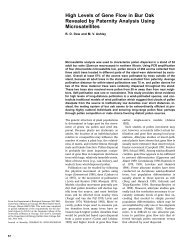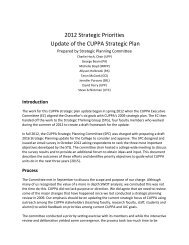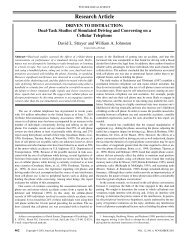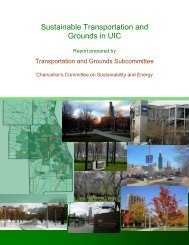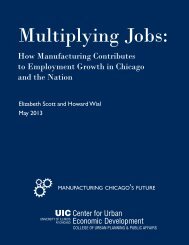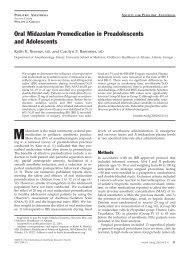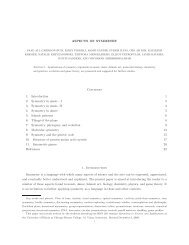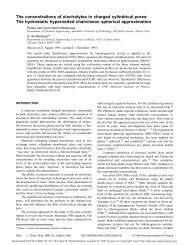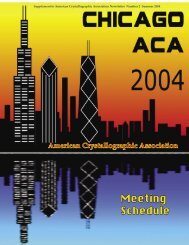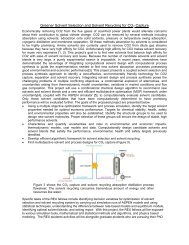Surface Tension Prediction for Liquid Mixtures - University of Illinois ...
Surface Tension Prediction for Liquid Mixtures - University of Illinois ...
Surface Tension Prediction for Liquid Mixtures - University of Illinois ...
Create successful ePaper yourself
Turn your PDF publications into a flip-book with our unique Google optimized e-Paper software.
AIChE Journal, Vol. 44, No. 10, pp. 2324-2332, 1998<br />
<strong>Surface</strong> <strong>Tension</strong> <strong>Prediction</strong> <strong>for</strong> <strong>Liquid</strong> <strong>Mixtures</strong><br />
Joel Escobedo and G. Ali Mansoori (*)<br />
Department <strong>of</strong> Chemical Engineering<br />
<strong>University</strong> <strong>of</strong> <strong>Illinois</strong> at Chicago<br />
810 S. Clinton Street, Chicago, IL 60607-7000, USA<br />
key words: <strong>Surface</strong> tension, organic fluids, mixtures, prediction, new mixing rules<br />
Abstract<br />
Recently Escobedo and Mansoori (AIChE J. 42(5): 1425, 1996) proposed a new expression,<br />
originally derived from statistical mechanics, <strong>for</strong> the surface tension prediction <strong>of</strong> pure fluids. In<br />
this report, the same theory is extended to the case <strong>of</strong> mixtures <strong>of</strong> organic liquids with the<br />
following expression,<br />
σ m = [(1-T r,m ) 0.37 T r,m exp (0.30066/T r,m + 0.86442 T r,m9 ) (P L 0,m ρ L,m - P V 0,m ρ v,m )]4<br />
P 0,m<br />
= { Σ i Σ j<br />
[x i x j (P cij / T cij ) 7/3 P 4 0,ij ]} 1/4 [Σ i Σ j<br />
(x i x j T cij / P cij )] 7/12<br />
P 0,ij<br />
=(1-m ij )(P 0,i<br />
P 0,j<br />
) 1/2<br />
where σ m is the surface tension <strong>of</strong> the mixture. T r,m =T/T c,m and T c,m is the pseudo-critical<br />
temperature <strong>of</strong> the liquid mixture. ρ L,m<br />
and ρ v,m<br />
are the equilibrium densities <strong>of</strong> liquid and<br />
vapor, respectively. P L 0,m and PV 0,m<br />
are the temperature-independent compound-dependent<br />
parameters <strong>for</strong> the liquid and vapor, respectively. P c,i , T c,i and x i are the critical pressure, critical<br />
temperature and the mole fraction <strong>for</strong> component i, respectively. P 0,i<br />
is the temperatureindependent<br />
parameter <strong>for</strong> component i and m ij is the unlike interaction parameter.<br />
Using the proposed equation surface tensions <strong>of</strong> 55 binary mixtures are predicted within an<br />
overall 0.50 AAD% which is better than the other available prediction methods. When the P 0,i<br />
’s<br />
are made compound-insensitive using a corresponding states expression the surface tension <strong>of</strong> all<br />
the 55 binary mixtures are predicted within an overall 2.10 AAD%. The proposed model is also<br />
applicable to multicomponent liquid mixtures.<br />
______________________________________________________________________________<br />
(*) To whom correspondence concerning this article should be addressed.<br />
1
AIChE Journal, Vol. 44, No. 10, pp. 2324-2332, 1998<br />
Introduction<br />
The surface tension <strong>of</strong> a liquid mixture is not a simple function <strong>of</strong> the surface tensions <strong>of</strong> the<br />
pure liquids. Also, the composition <strong>of</strong> the bulk phase and the composition at the vapor-liquid<br />
interface are not always the same. At the interface, there is migration <strong>of</strong> the species having the<br />
lowest surface tension, or free energy per unit area, at the temperature <strong>of</strong> the system. This<br />
migration at the interface results in a liquid-phase rich in the component with the highest surface<br />
tension and a vapor phase rich in the component with the lowest surface tension (Teixeira et al.,<br />
1992, Croxton, 1986, Carey et al, 1980;Winterfield et al., 1978; Massoudi and King, 1975,<br />
Wertheim,1976). According to Chapela et al., (1977) the more volatile component is adsorbed<br />
from the mixture and extends about one atomic diameter into the gas phase beyond the other<br />
species.<br />
In most instances the bulk composition is known. However, the composition at the vaporliquid<br />
interface is unknown. There<strong>for</strong>e, there is a need <strong>for</strong> relating the surface tension <strong>of</strong><br />
mixtures to bulk-phase concentrations and properties (i.e. densities).<br />
In general, there have been several approaches <strong>for</strong> estimating the surface tension <strong>of</strong> mixtures<br />
(i) based on empirical or semi-empirical thermodynamic relations suggested first <strong>for</strong> pure fluids<br />
and (ii)based on statistical mechanical grounds.<br />
In a recent publication Escobedo and Mansoori (1996) presented a set <strong>of</strong> new expressions<br />
<strong>for</strong> predicting the surface tension <strong>of</strong> pure fluids. These new expressions were developed from<br />
the statistical mechanical basis <strong>of</strong> the Macleod equation. It was shown that their new expressions<br />
represent rather accurately the surface tension <strong>of</strong> a variety <strong>of</strong> pure fluids over a wide range <strong>of</strong><br />
temperatures. In this paper, the expressions proposed originally by Escobedo and Mansoori<br />
(1996) are extended to the case <strong>of</strong> mixtures.<br />
Theory<br />
For the surface tension <strong>of</strong> pure organic fluids, σ, Escobedo and Mansoori (1996), proposed,<br />
σ = [P (ρ l<br />
- ρ v<br />
)] 4 (1)<br />
P = P 0<br />
(1-T r ) 0.37 Tr Exp(0.30066/T r + 0.86442 T r9 ) (2)<br />
where P is known as parachor, ρ l<br />
is the liquid density, ρ v<br />
is the vapor density, T r is the reduced<br />
temperature and P 0<br />
is a constant which is a function <strong>of</strong> the characteristics <strong>of</strong> the molecule under<br />
consideration. This new expression, derived from statistical mechanics, represents the<br />
experimental surface tension <strong>of</strong> 94 different organic compounds within 1.05 AAD%. In<br />
addition,<br />
P 0<br />
= 39.6431 [0.22217 - 2.91042× 10 -3 (R * /T br 2 )] T c<br />
13/12<br />
/ P c 5/6 (3)<br />
2
AIChE Journal, Vol. 44, No. 10, pp. 2324-2332, 1998<br />
was proposed as a corresponding-states expression <strong>for</strong> the temperature-independent, compounddependent<br />
parameter P 0<br />
. In this equation, R * = Rm/Rm,ref; Rm is the molar refraction given by<br />
Rm = (4πNA/3)[α +µ 2 f(T)] = (1/ρ)(n 2 -1)/(n 2 +2); α and µ are the polarizability and the dipole<br />
moment <strong>of</strong> the molecule; NA is the Avogadro’s number, n is the sodium-D light refractive index<br />
<strong>of</strong> a liquid at 20¡ C; Rm,ref=6.987 is the molar refraction <strong>of</strong> the reference fluid (methane). When<br />
this generalized expression is used, surface tensions <strong>for</strong> all the 94 pure compounds can be<br />
predicted within an overall 2.57 AAD% at all temperatures investigated.<br />
Exact statistical mechanical extension <strong>of</strong> equations 1-3 to mixtures results in quite complex<br />
expressions. However, using the principles <strong>of</strong> the con<strong>for</strong>mal solution theory (Massih and<br />
Mansoori, 1983) the following generalization <strong>of</strong> Eq. 2 <strong>for</strong> the case <strong>of</strong> mixtures will be concluded,<br />
σ m = [(1-T rm ) 0.37 Tr,m exp (0.30066/T r,m + 0.86442 T r,m9 ) (P L 0,m ρ L,m - P V 0,m ρ v,m )]4 (4)<br />
where σ m is the surface tension <strong>of</strong> the mixture; P L 0,m and PV 0,m<br />
are the temperature-independent<br />
con<strong>for</strong>mal parameters <strong>for</strong> the liquid and vapor phase, respectively; T r,m is the pseudo-reduced<br />
temperature <strong>for</strong> the mixture (i.e. T r,m<br />
= T / T c,m ); T c,m is the pseudo-critical temperature <strong>of</strong> the<br />
liquid mixture); and ρ L,m<br />
and ρ v,m<br />
are the equilibrium densities <strong>of</strong> the liquid and vapor phase,<br />
respectively. The aim <strong>of</strong> this report is the application <strong>of</strong> Eq. 4 <strong>for</strong> the prediction <strong>of</strong> the surface<br />
tension <strong>of</strong> mixtures, over the whole concentration range from the temperature-independent<br />
parameter P 0<br />
<strong>for</strong> the pure components. In order to apply Eq. 4 to mixtures we need the<br />
following,<br />
1. Accurate prediction <strong>of</strong> phase equilibrium properties (i.e. composition <strong>of</strong> the liquid and vapor<br />
phases, vapor and liquid densities, and saturation pressures).<br />
2. Mixing rules <strong>for</strong> the temperature-independent parameter P 0<br />
in order to calculate the<br />
temperature-independent parameters P L 0,m and PV 0,m<br />
<strong>for</strong> the liquid-and vapor-phase<br />
mixtures.<br />
<strong>Prediction</strong> <strong>of</strong> Phase Equilibrium Properties<br />
In this work, the equilibrium properties <strong>for</strong> a multicomponent mixture were calculated in<br />
two steps.<br />
First, the Peng-Robinson (PR) equation <strong>of</strong> state was used to predict the vapor pressure and<br />
liquid- and vapor-phase compositions. The PR equation <strong>of</strong> state was selected <strong>for</strong> this purpose<br />
because its parameters are known <strong>for</strong> many pure compounds and because its interaction<br />
parameters are available <strong>for</strong> numerous binary mixtures. Since the constants <strong>of</strong> the PR equation<br />
are fitted to vapor pressure data it is reliable <strong>for</strong> vapor-liquid-equilibrium (VLE) calculations.<br />
Second, the predicted compositions and vapor pressure by the PR equation were in turn used<br />
3
AIChE Journal, Vol. 44, No. 10, pp. 2324-2332, 1998<br />
with the Riazi-Mansoori (RM) equation <strong>of</strong> state (described below) to predict the densities <strong>of</strong> the<br />
liquid and vapor phases. The RM equation <strong>of</strong> state yields more accurate density predictions than<br />
the PR equation.<br />
The calculations described above have been incorporated into a comprehensive computer<br />
package <strong>for</strong> vapor-liquid-equilibrium (VLE) calculations. This computer package has been used<br />
to per<strong>for</strong>m the routine bubble-point and flash calculations.<br />
The PR equation <strong>of</strong> state is given by,<br />
P = RT / (V - b) - aα /(V 2 + 2bV - b 2 ) (5)<br />
where P, T, and V=1/ρ are pressure, temperature, and molar volume, respectively; R is the<br />
universal gas constant; a = 0.45724 R 2 T c<br />
2 / P c ; b = 0.07780 RT c / P c ; T c is the critical<br />
temperature; P c is the critical pressure; α = [1 + (0.37464+ 1.5422 ω - 0.26992 ω 2 )(1 - T r<br />
0.5 )] 2 ;<br />
ω is the acentric factor; T r =T/T c is the reduced temperature. The mixing rules <strong>for</strong> the<br />
temperature-dependent term (a α) and constant b are given by: (a α) m = ΣΣ [x i x j (a α) ij ] and b m =<br />
Σ (x i b i ), respectively; (a α) m is the temperature-dependent parameter <strong>for</strong> the mixture; b m is the<br />
volume-related constant <strong>for</strong> the mixture; and x i is the mole fraction <strong>of</strong> species i in the mixture.<br />
The cross-parameters are calculated using the following expression, (a α) ij = (1-k ij )[(aα) i (aα) j ] 1/2<br />
; where k ij is a binary interaction parameter. This interaction parameter is calculated using a<br />
correlation recently proposed by Gao, 1992: (1 - k ij<br />
PR) = [2 (T ci T cj ) 1/2 / (T ci +T cj )] Zc ij<br />
; Z cij<br />
=[(Z ci + Z cj )/2]; where Z ci is the critical compressibility factor <strong>for</strong> pure component i.<br />
Bubble-point and flash calculations are per<strong>for</strong>med using the above equation <strong>of</strong> state<br />
following the standard algorithms reported in textbooks (Walas, 1985). The predicted saturation<br />
pressure and vapor- and liquid-phase compositions are then used along with the Riazi-Mansoori<br />
(1993) equation <strong>of</strong> state (RM EOS) to calculate the equilibrium densities <strong>for</strong> the vapor and liquid<br />
phases. The RM EOS is given below,<br />
P = ρRT/(1-bρ) -aρ 2 /[T 1/2. (1+bρ)] (6)<br />
a = 0.42748 R 2 T c<br />
2.5/P c and b = (0.08664 RT c<br />
/P c ) . δ(R * ,T r )<br />
δ -1 = 1+{ 0.02[1 - 0.92 exp (-1000⎪ T r - 1⎪ )]-0.035(T r - 1)} (R * - 1)<br />
R * = Rm/Rm,ref; Rm = (4πNA/3)[α + µ 2 f(T)] = (1/ρ)(n 2 -1)/(n 2 +2); Rm,ref=6.987<br />
where ρ is the molar density; T, P, T c , P c , T r , and R are as previously defined; Rm is the molar<br />
refraction; Rm,ref is the molar refraction <strong>of</strong> the reference compound(methane); α and µ are the<br />
polarizability and the dipole moment <strong>of</strong> the molecule; NA is the Avogadro’s number, n is the<br />
sodium-D light refractive index <strong>of</strong> a liquid at 20¡ C (Riazi and Mansoori, 1993).<br />
In order to apply Eq. 6 to the case <strong>of</strong> mixtures the van der Waals mixing rules and the<br />
4
AIChE Journal, Vol. 44, No. 10, pp. 2324-2332, 1998<br />
molecular expressions <strong>for</strong> the cross-parameters (Riazi and Mansoori, 1993) have been used,<br />
T cm = Σ i Σ j<br />
[x i x j (T cij 2 / P cij )] / Σ i Σ j<br />
[x i x j (T cij / P cij )]<br />
T cij = (1 - k ij<br />
RM) (T ci T cj ) 1/2<br />
P cm = Σ i Σ j<br />
[x i x j (T cij 2 / P cij )] / { Σ i Σ j<br />
[x i x j (T cij / P cij )]} 2<br />
(6a)<br />
(6b)<br />
(6c)<br />
P cij = 8 T cij / [(T cii / P cii ) 1/3 + (T cjj / P cjj ) 1/3 ] 3<br />
R * m = Σ i Σ j<br />
(x i x j R * ij )<br />
R * ij = [R* ii 1/3 + R * jj 1/3 ] 3 / 8<br />
(6d)<br />
(6e)<br />
(6f)<br />
In these equations, T cm is the pseudo-critical temperature <strong>of</strong> the mixture; T ci is the critical<br />
temperature <strong>of</strong> pure component i in the mixture; P cm is the pseudo-critical pressure <strong>of</strong> the<br />
mixture; P ci is the critical pressure <strong>of</strong> pure component i in the mixture; P cij is a cross-parameter<br />
<strong>for</strong> pressure; k RM ij is the binary interaction parameter (RM stands <strong>for</strong> Riazi-Mansoori to<br />
differentiate it from the interaction parameter used in the PR equation <strong>of</strong> state); R * m is the<br />
dimensionless molar refraction <strong>of</strong> the mixture; R * i is the dimensionless molar refraction <strong>of</strong> pure<br />
component i in the mixture; and x i is the mole fraction <strong>of</strong> component i in the mixture. The<br />
binary interaction parameter, k ij<br />
RM, is calculated using the following expression,<br />
(1 - k ij<br />
RM) = (1 - k ij<br />
PR) { 8 [(T cii / P cii )(T cjj / P cjj )] 1/2 / [(T c ii<br />
/ P cii ) 1/3 + (T cjj / P cjj ) 1/3 ] 3 } (6g)<br />
Mixing Rules <strong>for</strong> the Temperature-independent parameter P o<br />
This section is devoted to the development <strong>of</strong> the mixing rules <strong>for</strong> the temperatureindependent<br />
parameter P o<br />
. These mixing rules may be derived considering the proportionality <strong>of</strong><br />
P o<br />
to the intermolecular parameters(or critical properties) according to Kwak and Mansoori<br />
(1986). Following the principle <strong>of</strong> corresponding states a reduced surface tension may be defined<br />
as σ r = σ / [T 2/3 c (kT c ) 1/3 ] and expected to be a universal function <strong>of</strong> T r = T/T c (i.e. the<br />
reduced temperature). Thus, it can be shown that,<br />
P o,ii<br />
∝ T c<br />
13/12<br />
/ P c 5/6 (7)<br />
It may be assumed that the temperature-independent parameter, P o,m<br />
, <strong>for</strong> the mixture will follow<br />
the same proportionality with respect to the critical temperature and pressure <strong>of</strong> the mixture,<br />
P o,m<br />
∝ . T c,m<br />
13/12<br />
/ P c,m 5/6 (8)<br />
5
AIChE Journal, Vol. 44, No. 10, pp. 2324-2332, 1998<br />
where T c,m<br />
and P c,m<br />
are the pseudo-critical temperature and pressure <strong>for</strong> the mixture,<br />
respectively. Introducing the van der Waals mixing rules <strong>for</strong> T c,m<br />
and P c,m<br />
, Eqs. 6a and 6c, into<br />
Eq. 8 the following expression is obtained,<br />
P o,m<br />
∝ {Σ i Σ j<br />
(x i x j T cij 2 /P cij<br />
)/Σ i Σ j<br />
(x i x j T cij<br />
/P cij<br />
)} 13/12 /{Σ i Σ j<br />
(x i x j T cij 2 /P cij<br />
)/[Σ i Σ j<br />
(x i x j T cij<br />
/P cij<br />
)] 2 } 5/6<br />
this equation may be further reduced to the following expression,<br />
(9)<br />
P o,m<br />
∝ [Σ i Σ j<br />
x i x j (T cij 2 / P cij )] 1/4 [Σ i Σ j<br />
x i x j (T cij / P cij )] 7/12 (10)<br />
the term (T cij 2 / P cij ) maybe further simplified to obtain,<br />
T cij 2 / P cij =(T cij 11/12 / P cij 1/6 ) (T cij 13/12 / P cij 5/6 ) (11)<br />
notice that the term within the second bracket on the right-hand side <strong>of</strong> Eq. 11 is nothing but P o,ij<br />
given by Eq. 7. Thus, Eq. 11may be rewritten as follows,<br />
T cij 2 / P cij =(T cij 11/12 / P cij 1/6 ) P 0,ij<br />
(12)<br />
Eq. 12 can further be rearranged as follows,<br />
T cij 2 / P cij =(P cij / T cij ) 7/3 P 4 0,ij<br />
(13)<br />
By introducing Eq. 13 back into Eq. 10the following expression <strong>for</strong> P o,m<br />
is obtained,<br />
P o,m<br />
= . [Σ i Σ j<br />
x i x j (P cij / T cij ) 7/3 P 4 0,ij] 1/4 [Σ i Σ j<br />
x i x j (T cij / P cij )] 7/12 (14)<br />
Eq. 14 represents the general van der Waals mixing rule proposed in this work <strong>for</strong> calculation <strong>of</strong><br />
the temperature-independent parameter, P o,m<br />
, <strong>for</strong> a multicomponent mixture. The crossparameters<br />
may be calculated using the following expression,<br />
6
AIChE Journal, Vol. 44, No. 10, pp. 2324-2332, 1998<br />
P o,ij<br />
= (1 - m ij ) (P 0,ii<br />
.P 0,jj<br />
) 1/2 (15)<br />
where m ij is a binary interaction parameter. The cross-parameters <strong>for</strong> temperature and pressure<br />
in Eq. 14 may be calculated using Eq. 6b and 6d, respectively.<br />
For the case <strong>of</strong> binary mixtures, the equations to calculate the temperature-independent<br />
parameters, P L o,m and PV o,m<br />
, <strong>for</strong> the liquid phase is the following,<br />
The temperature-independent parameter P v o<br />
<strong>for</strong> the vapor-phase mixture is calculated by<br />
replacing the x i ’sin Eq. 16 by the compositions <strong>of</strong> the vapor phase (i.e. y i ’s). The crossparameters<br />
are then given by,<br />
P o,12<br />
= (1 - m 12 ) (P 0,1<br />
.P 0,2<br />
) 1/2<br />
T c12<br />
= (1 - k 12<br />
RM) (T c1<br />
T c2<br />
) 1/2<br />
P c12<br />
= 8 T c12 / [(T c1<br />
/ P c1<br />
) 1/3 + (T c2<br />
/ P c2<br />
) 1/3 ] 3<br />
(16a)<br />
(16b)<br />
(16c)<br />
Eq. 16 may be used along with Eq. 4 to predict the surface tension <strong>of</strong> binary mixtures. In the<br />
following sections the results <strong>for</strong> 55 binary mixtures are reported. Table 1 shows the physical<br />
properties <strong>of</strong> the pure fluids involved in these binary mixtures.<br />
The most widely used mixing rules <strong>for</strong> the temperature-independent parameter, P o<br />
, in Eq. 4<br />
used in the petroleum industry were proposed by Weinaug and Katz (1943) as follows,<br />
P o,m<br />
= Σ(x i P o,i ) (17)<br />
Because <strong>of</strong> the simplicity <strong>of</strong> this mixing rule, it was decided to investigate the results obtained<br />
with Eq. 4 and this simple mixing rule as a preliminary step. Thus, the surface tension <strong>of</strong> all 55<br />
binary mixtures were predicted using the following procedure (CASE 1)<br />
(a) The temperature-independent parameter P o<br />
<strong>for</strong> the pure compounds were obtained by fitting<br />
Eq. 1 to the experimental surface tension <strong>for</strong> the pure compounds.<br />
(b) Routine VLE calculations were per<strong>for</strong>med using a computer package developed in our<br />
laboratory to obtain the vapor- and liquid-phase compositions as well as the saturation<br />
pressure. The results from the VLE calculations were used along with the Riazi-Mansoori<br />
7
AIChE Journal, Vol. 44, No. 10, pp. 2324-2332, 1998<br />
equation <strong>of</strong> state to predict the vapor and liquid densities.<br />
(c) Finally, Eqs. 4 and 17 were used to predict the surface tension <strong>for</strong> the mixture.<br />
The results obtained <strong>for</strong> this CASE 1 are reported in Table 2. Note that the surface tension <strong>of</strong> all<br />
55 sets <strong>of</strong> binary-mixture data can be predicted with an overall 2.64 AAD%.<br />
<strong>Surface</strong> <strong>Tension</strong> <strong>Prediction</strong> <strong>for</strong> Binary <strong>Mixtures</strong><br />
As mentioned earlier, Eqs. 4, 16, 16a-16c,proposed in this work, represent the necessary<br />
expressions to predict the surface tension <strong>of</strong> binary liquid mixtures. These expressions relate the<br />
surface tension <strong>of</strong> the mixture to the bulk properties <strong>of</strong> the system such as the vapor- and liquidphase<br />
compositions and vapor- and liquid-phase densities. There<strong>for</strong>e, only the temperatureindependent<br />
parameter P o<br />
<strong>for</strong> the pure components is needed. This parameter can be obtained<br />
by fitting Eq. 1 to the experimental surface tension data <strong>for</strong> the pure fluids. It may also be<br />
predicted using the corresponding-states expression given in Eq. 3.<br />
In this work, we have predicted the surface tension <strong>for</strong> 55 binary mixtures and compared the<br />
results against the experimental data <strong>for</strong> these systems. The selected systems represent a wide<br />
variety <strong>of</strong> binary mixtures (symmetric, asymmetric, and slightly asymmetric). The interaction<br />
parameter, m ij , appearing in Eq. 15 has been treated as an adjustable parameter <strong>for</strong> all the<br />
mixtures investigated.<br />
The surface tension <strong>for</strong> all the binary mixtures was predicted following the procedure<br />
outlined below,<br />
(a) The temperature-independent parameter P o<br />
<strong>for</strong> the pure compounds were obtained in two<br />
ways: CASE 2 by fitting Eq. 1 to the experimental surface tension <strong>for</strong> the pure compounds;<br />
and CASE 3 by predicting them using Eq. 3.<br />
(b) VLE calculations were per<strong>for</strong>med using a computer package developed according to what<br />
was discussed above to obtain the vapor- and liquid-phase compositions as well as the<br />
saturation pressure. The results from the VLE calculations were used along with the Riazi-<br />
Mansoori equation <strong>of</strong> state to predict the equilibrium vapor and liquid densities.<br />
(c) Finally, Eqs. 4, 16, and 16a-16c were used to predict the surface tension <strong>for</strong> the mixture.<br />
The results obtained <strong>for</strong> these two cases are also reported in Table 2. It must be pointed out that<br />
the interaction parameter, m ij ’s in CASE 2 and CASE 3 are different. There<strong>for</strong>e, a different value<br />
<strong>for</strong> each case is reported in Table2.<br />
Results and Discussion <strong>for</strong> Binary <strong>Mixtures</strong><br />
Table 2 contains the results obtained <strong>for</strong> CASES1, 2, and 3. This table also reports<br />
temperature, experimental data reference, and number <strong>of</strong> data points <strong>for</strong> each binary mixture.<br />
CASE 2<br />
The average absolute percent deviation (AAD%) obtained when the binary interaction<br />
8
AIChE Journal, Vol. 44, No. 10, pp. 2324-2332, 1998<br />
parameter (m ij ) was set equal to zero is reported. Note that the surface tension <strong>for</strong> all the 55<br />
binary mixtures can be predicted within an overall 2.06 AAD%. It may also be noticed that even<br />
when m ij is set equal to zero the surface tension <strong>for</strong> most binary mixtures can be predicted with<br />
reasonable accuracy. This represents an improvement over the simple mixing rule (CASE 1)as<br />
shown in Table 2. In a different calculation <strong>for</strong> CASE 2, the binary interaction parameters, m ij ,<br />
were fitted to all binary mixtures. The best value <strong>for</strong> this parameter is also reported in Table 2.<br />
It may be noted that this interaction parameter is small <strong>for</strong> all the systems investigated. Note also<br />
that when this optimized interaction parameter was used the surface tension <strong>of</strong> all 55 binary<br />
mixtures can be predicted within an overall0.50 AAD%. Figures 1 through 9 show the results<br />
obtained <strong>for</strong> CASE 2 when the best value <strong>for</strong> the binary interaction parameter used in the<br />
prediction <strong>of</strong> surface tension <strong>for</strong> the binary systems. Note the excellent agreement with the<br />
experimental data.<br />
CASE 3<br />
The AAD% obtained when the binary interaction parameter (m ij ) was set equal to zero and<br />
the parameters P o<br />
are predicted using Eq. 3 is reported in Table 2. Note that the surface tension<br />
<strong>for</strong> all the55 binary mixtures can be predicted within an overall 3.70 AAD%. It must be pointed<br />
out that by setting the binary interaction parameters equal to zero the surface tension is purely<br />
predicted since the only adjustable parameter is eliminated. Note that predictions thus made are<br />
in good agreement with the experimental data except in a few cases where Eq. 3 fails to yield<br />
good estimates <strong>for</strong> the parameter P o<br />
. In another set <strong>of</strong> calculation <strong>for</strong> CASE 3 the binary<br />
interaction parameter (m ij ) was fitted to the experimental data. The best values <strong>for</strong> this parameter<br />
are also reported in Table2. Note that that when this optimized interaction parameter was used<br />
the surface tension <strong>of</strong> all the 55 binary mixtures can be predicted within an overall 2.10 AAD%.<br />
It should be pointed out that in the absence <strong>of</strong> surface tension data <strong>for</strong> pure compounds, Eqs.<br />
3, 4, and 14 (CASE 3) represent an excellent tool to predict the surface tension <strong>of</strong> mixtures <strong>of</strong><br />
organic compounds. Good predictions will be obtained even when the binary interaction<br />
parameter, m ij , is set equal to zero.<br />
Conclusions<br />
Based on the 55 sets <strong>of</strong> binary-mixture surface tension data analyzed in this work we may<br />
conclude that the expressions proposed in this work <strong>for</strong> surface tension prediction <strong>of</strong> mixtures are<br />
very good. These predictions are made using only the values <strong>of</strong> the temperature-independent<br />
parameter P o<br />
<strong>for</strong> the pure components in the mixture. This parameter may be obtained from<br />
experimental surface tensions <strong>of</strong> the pure components or estimated using Eq. 3. It is also worth<br />
noting that in these calculations only one adjustable parameter has been used namely the binary<br />
interaction parameter, m ij , appearing in Eq. 15.<br />
There exist a number <strong>of</strong> other methods <strong>for</strong> prediction <strong>of</strong> the surface tension <strong>of</strong> liquid<br />
mixtures. None <strong>of</strong> the other methods are as accurate in predicting mixture surface tension except<br />
9
AIChE Journal, Vol. 44, No. 10, pp. 2324-2332, 1998<br />
the ones by Carey et. al., (1980) and Winterfeld et al., (1978). The latter two methods report<br />
very accurate prediction <strong>of</strong> surface tension <strong>of</strong> mixtures provided pure fluid surface tension data<br />
are available.<br />
It may be concluded that the expressions proposed in this work are general since they have<br />
been applied to a variety <strong>of</strong> binary mixtures and the results obtained are in good agreement with<br />
the experimental data. Application <strong>of</strong> the present method to multicomponent mixtures is straight<br />
<strong>for</strong>ward. However, little reliable data are available <strong>for</strong> multicomponent surface tensions <strong>for</strong><br />
reliable comparisons.<br />
10
AIChE Journal, Vol. 44, No. 10, pp. 2324-2332, 1998<br />
TABLE 1: Properties <strong>of</strong> the pure fluids involved in the 55 binary mixtures studied in this work<br />
_________________________________________________________________________________________<br />
Compound T c P c Z c ω R* T b<br />
________________________________________________________________________________________<br />
Acetone 508.1 47. 0.232 0.304 2.316 329.2<br />
Acetonitrile 545.5 48.3 0.184 0.321 1.585 354.8<br />
Benzene 562.2 48.9 0.271 0.212 3.748 353.2<br />
Carbon Disulfide 552. 79. 0.276 0.109 3.079 319.<br />
Carbon Tetrachloride 556.4 49.6 0.272 0.193 3.784 349.9<br />
Chloro<strong>for</strong>m 536.4 53.7 0.293 0.218 3.071 334.3<br />
Cyclopentane 511.7 45.1 0.275 0.196 3.310 322.4<br />
Cyclohexane 553.5 40.7 0.273 0.212 3.966 353.8<br />
Cis-Decalin 702.3 32. 0.245 0.286 6.281 468.9<br />
Trans-Decalin 687.1 31.4 0.245 0.270 6.341 460.5<br />
n-Decane 617.7 21.2 0.249 0.489 6.915 447.3<br />
Dichloromethane 510. 63. 0.265 0.1916 2.339 313.<br />
n-Dodecane 658.2 18.2 0.240 0.575 8.269 489.5<br />
Ethyl Acetate 523.2 38.3 0.252 0.362 3.186 350.3<br />
Ethyl Ether 466.7 36.4 0.262 0.281 3.219 307.6<br />
n-Hexane 507.5 30.1 0.264 0.299 4.281 341.9<br />
Iodomethane 528. 65.9 N/A 0.1493 2.788 315.7<br />
Iso-Octane 544. 25.7 0.266 0.303 5.619 372.4<br />
Nitromethane 588. 63.1 0.208 0.310 1.787 374.3<br />
Phenol 694.2 61.3 0.240 0.438 4.001 455.<br />
Tetrachloroethylene 620.2 47.6 0.250 0.254 4.341 394.4<br />
Toluene 591.8 41. 0.263 0.263 4.450 383.8<br />
o-Xylene 630.3 37.3 0.262 0.310 5.124 417.6<br />
_____________________________________________________________________________________________<br />
The critical properties and acentric factor were obtained from Reid et al., 1986. The parameter<br />
Po was obtained from experimental surface tension data <strong>for</strong> pure components; The dimensionless<br />
molar refraction R* was obtained from data <strong>for</strong> molar refraction reported by Hall (1986) or<br />
calculated using the Lorentz-Lorenz function. For Iodomethane, the acentric factor was<br />
estimated by predicting the vapor pressure at Tr = 0.7 using the Antoine equation <strong>for</strong> vapor<br />
pressure prediction. The constants <strong>for</strong> this equation were obtained from Hall (1986). For<br />
Iodomethane there was no experimental critical compressibility factor.<br />
11
AIChE Journal, Vol. 44, No. 10, pp. 2324-2332, 1998<br />
TABLE 2 Results obtained <strong>for</strong> the 55 sets <strong>of</strong> binary mixtures investigated in this work<br />
__________ _____________________ ______________________<br />
CASE 1 CASE 2 CASE 3<br />
__________ _____________________ ______________________<br />
AAD% fitted AAD% fitted<br />
Binary system AAD% m ij =0 m ij AAD% m ij =0 m ij AAD% T (K) Ref. # data<br />
Acetone- Chloro<strong>for</strong>m 0.42 0.48 0.0050 0.09 1.69 -0.0095 0.94 291.15 A 5<br />
Acetone - Carbon disulfide 3.06 1.42 0.0157 0.21 3.13 -0.0087 2.31 288.15 A 5<br />
Acetone - Phenol 3.64 3.64 0.0305 1.72 10.24 0.0717 3.13 293.15 A 5<br />
Benzene - Acetone 0.75 0.69 -0.0061 0.29 5.61 -0.0326 2.24 298.15 B 9<br />
Benzene - Carbon tetrachloride 0.22 0.22 0.0000 0.22 1.98 -0.0064 1.67 298.15 B 11<br />
Benzene - Carbon disulfide 2.77 0.31 0.0035 0.16 1.94 0.0000 1.94 291.15 A 11<br />
Benzene - Ethyl acetate 1.00 0.69 0.0060 0.13 6.35 -0.0346 2.79 298.15 B 11<br />
Benzene - Ethyl ether 2.46 2.36 0.0202 0.44 2.21 0.0150 1.19 291.15 A 5<br />
Benzene - n-Dodecane 1.74 6.17 -0.0705 0.70 7.06 -0.0659 0.96 298.15 C 5<br />
Benzene - n-Dodecane 2.37 4.79 -0.0705 1.72 6.16 -0.0659 1.06 303.15 C 5<br />
Benzene - n-Dodecane 1.78 4.94 -0.0705 1.30 6.01 -0.0659 1.08 308.15 C 5<br />
Benzene - n-Dodecane 2.07 6.06 -0.0705 1.05 6.88 -0.0659 0.71 313.15 C 5<br />
Benzene - n-Hexane 4.04 3.11 0.0275 0.97 2.16 0.0140 1.12 298.15 C 7<br />
Benzene - n-Hexane 3.70 2.86 0.0275 0.39 2.36 0.0140 1.04 303.15 C 5<br />
Benzene - n-Hexane 3.86 2.93 0.0275 0.69 2.38 0.0140 1.01 308.15 C 5<br />
Benzene - n-Hexane 3.18 2.39 0.0275 0.63 1.80 0.0140 1.04 313.15 C 5<br />
Benzene - Nitromethane 3.47 3.69 0.0220 1.13 2.84 0.0059 2.82 298.15 A 6<br />
Benzene - o-Xylene 0.45 0.73 -0.0060 0.05 2.40 -0.0143 0.73 298.15 D 10<br />
Benzene - Phenol 3.50 3.52 0.0338 0.28 10.67 0.0672 4.38 308.15 A 5<br />
CCl 4 -Ethyl acetate 0.69 0.50 0.0020 0.45 4.87 -0.0232 2.73 298.15 B 11<br />
Carbon disulfide – CCl 4 2.55 0.76 0.0077 0.31 4.37 0.0296 1.45 293.15 E 10<br />
Carbon disulfide - CCl 4 2.57 0.75 0.0077 0.25 4.39 0.0296 1.40 298.15 E 10<br />
Carbon disulfide - CCl 4 2.76 0.94 0.0077 0.21 4.52 0.0296 1.43 303.15 E 10<br />
Carbon disulfide - CCl 4 2.81 0.98 0.0077 0.23 4.56 0.0296 1.49 308.15 E 10<br />
Carbon disulfide - CCl 4 2.75 0.92 0.0077 0.30 4.47 0.0296 1.42 313.15 E 10<br />
Carbon disulfide - CCl 4 2.91 1.08 0.0077 0.41 4.59 0.0296 1.43 318.15 E 10<br />
Carbon disulfide - Benzene 3.56 1.29 0.0073 0.53 3.08 0.0065 2.95 298.15 B 6<br />
Cyclopentane - CCl 4 0.29 0.31 0.0033 0.10 1.61 0.0083 0.96 298.15 D 10<br />
Cyclopentane - Benzene 2.42 2.42 0.0182 0.19 1.31 0.0070 0.77 298.15 D 11<br />
Cyclopentane - Toluene 1.88 1.27 0.0099 0.12 0.62 0.0035 0.44 298.15 D 12<br />
Cyclopentane-Tetrachloroethylene 2.01 1.84 0.0151 0.19 2.06 0.0159 0.68 298.15 D 11<br />
Cyclohexane - Benzene 2.36 1.99 0.0169 0.14 0.82 0.0026 0.64 293.15 D 11<br />
Cyclohexane - Benzene 1.98 1.77 0.0169 0.31 1.00 0.0026 0.98 303.15 D 11<br />
Cyclohexane - cis-Decalin 0.67 1.12 -0.0102 0.12 3.70 -0.0219 1.27 298.15 D 11<br />
Cyclohexane - trans-Decalin 0.31 1.38 -0.0113 0.11 1.76 -0.0121 0.37 298.15 D 11<br />
Cyclohexane-Tetrachloroethylene 1.95 1.94 0.0152 0.16 1.89 0.0134 0.80 298.15 D 11<br />
Cyclohexane - Toluene 1.93 1.86 0.0152 0.14 0.90 0.0055 0.61 298.15 D 13<br />
Ethyl ether - Carbon disulfide 5.27 2.49 0.0183 1.87 5.19 0.0459 4.03 291.15 A 6<br />
Iodomethane - CCl 4 2.15 1.72 0.0118 0.99 2.90 0.0036 2.77 288.15 F 5<br />
Iodomethane - CCl 4 2.65 2.15 0.0118 0.65 2.73 0.0036 2.60 293.15 F 8<br />
12
AIChE Journal, Vol. 44, No. 10, pp. 2324-2332, 1998<br />
Iodomethane - CCl 4 2.57 1.93 0.0118 0.51 2.34 0.0036 2.34 298.15 F 14<br />
TABLE 2 (continued)<br />
__________ _____________________ ______________________<br />
CASE 1 CASE 2 CASE 3<br />
__________ _____________________ ______________________<br />
AAD% fitted AAD% fitted<br />
Binary system AAD% m ij =0 m ij AAD% m ij =0 m ij AAD% T (K) Ref. # data<br />
Iodomethane - CCl 4 2.64 1.99 0.0118 0.48 2.50 0.0036 2.47 303.15 F 11<br />
Iodomethane - CCl 4 2.37 1.80 0.0118 0.37 3.08 0.0036 3.21 308.15 F 9<br />
Iso-Octane - Benzene 3.55 1.18 0.0096 0.58 3.00 0.0169 1.42 303.15 G 9<br />
Iso-Octane - Cyclohexane 1.08 0.24 0.0000 0.24 2.50 0.0101 1.50 303.15 G 5<br />
Iso-Octane - n-Dodecane 1.16 1.59 -0.0147 0.29 1.53 -0.0050 1.45 303.15 G 9<br />
Acetonitrile - Carbon tetrachloride 1.56 1.97 0.0160 0.82 4.57 -0.0066 4.47 298.15 F 9<br />
Acetonitrile - Carbon tetrachloride 1.45 1.98 0.0160 0.79 4.98 -0.0066 5.02 303.15 F 8<br />
Acetonitrile - Carbon tetrachloride 1.75 2.10 0.0160 0.65 4.74 -0.0066 4.64 308.15 F 9<br />
Acetonitrile - Carbon tetrachloride 1.78 2.16 0.0160 0.54 5.59 -0.0066 5.48 313.15 F 10<br />
Acetonitrile - Carbon tetrachloride 1.86 2.22 0.0160 0.61 5.68 -0.0066 5.58 318.15 F 9<br />
Dichloromethane-Carbon disulfide 3.21 2.97 0.0290 0.27 4.31 0.0304 3.04 293.15 H 8<br />
Dichloromethane-Carbon disulfide 3.76 3.48 0.0290 0.20 4.06 0.0304 2.80 298.15 H 9<br />
Dichloromethane-Carbon disulfide 3.97 3.69 0.0290 0.55 4.69 0.0304 3.15 303.15 H 10<br />
Dichloromethane-Carbon disulfide 3.76 3.47 0.0290 0.46 4.54 0.0304 3.32 308.15 H 10<br />
Overall AAD% 2.64 2.06 0.50 3.70 2.10<br />
_________________________________________________________________________________________<br />
REFERENCES:<br />
A : Meissner and Michaels (1949); B : Shipp (1970); C : Schmidt et al., (1966); D : Lam and Benson (1970);<br />
E : Luengo et al., (1988); F : Texeira et al., (1992); G : Evans and Clever, 1964; H : Aracil et al., 1989.<br />
13
AIChE Journal, Vol. 44, No. 10, pp. 2324-2332, 1998<br />
x (Benzene)<br />
x (Benzene)<br />
29<br />
28<br />
0 0.1 0.2 0.3 0.4 0.5 0.6 0.7 0.8 0.9 1<br />
298.15°K<br />
0 0.1 0.2 0.3 0.4 0.5 0.6 0.7 0.8 0.9 1<br />
303.15°K<br />
28<br />
27<br />
27<br />
26<br />
<strong>Surface</strong> <strong>Tension</strong> (dynes/cm)<br />
26<br />
25<br />
24<br />
23<br />
22<br />
21<br />
20<br />
19<br />
18<br />
25<br />
24<br />
23<br />
22<br />
21<br />
20<br />
19<br />
18<br />
<strong>Surface</strong> <strong>Tension</strong> (dynes/cm)<br />
17<br />
17<br />
27<br />
26<br />
308.15°K<br />
313.15°K<br />
27<br />
26<br />
25<br />
25<br />
<strong>Surface</strong> <strong>Tension</strong> (dynes/cm)<br />
24<br />
23<br />
22<br />
21<br />
20<br />
19<br />
18<br />
17<br />
24<br />
23<br />
22<br />
21<br />
20<br />
19<br />
18<br />
17<br />
<strong>Surface</strong> <strong>Tension</strong> (dynes/cm)<br />
16<br />
0 0.1 0.2 0.3 0.4 0.5 0.6 0.7 0.8 0.9 1<br />
x (Benzene)<br />
0 0.1 0.2 0.3 0.4 0.5 0.6 0.7 0.8 0.9 1<br />
x (Benzene)<br />
16<br />
Figure 1 <strong>Surface</strong> <strong>Tension</strong>, σ, versus mole fraction <strong>of</strong> benzene in the liquid mixture <strong>for</strong> the<br />
system Benzene - n-Hexane. The squares indicate the experimental data (Schmidt et<br />
al., 1966). The solid line represents the values calculated with Eqs. 4 and 16.<br />
14
AIChE Journal, Vol. 44, No. 10, pp. 2324-2332, 1998<br />
x (Benzene)<br />
x (Benzene)<br />
30<br />
0 0.1 0.2 0.3 0.4 0.5 0.6 0.7 0.8 0.9 1<br />
298.15°K<br />
0 0.1 0.2 0.3 0.4 0.5 0.6 0.7 0.8 0.9 1<br />
303.15°K<br />
30<br />
29<br />
29<br />
<strong>Surface</strong> <strong>Tension</strong> (dynes/cm)<br />
28<br />
27<br />
26<br />
25<br />
24<br />
23<br />
28<br />
27<br />
26<br />
25<br />
24<br />
23<br />
<strong>Surface</strong> <strong>Tension</strong> (dynes/cm)<br />
22<br />
22<br />
30<br />
308.15°K<br />
313.15°K<br />
30<br />
29<br />
29<br />
<strong>Surface</strong> <strong>Tension</strong> (dynes/cm)<br />
28<br />
27<br />
26<br />
25<br />
24<br />
23<br />
28<br />
27<br />
26<br />
25<br />
24<br />
23<br />
<strong>Surface</strong> <strong>Tension</strong> (dynes/cm)<br />
22<br />
0 0.1 0.2 0.3 0.4 0.5 0.6 0.7 0.8 0.9 1<br />
x (Benzene)<br />
0 0.1 0.2 0.3 0.4 0.5 0.6 0.7 0.8 0.9 1<br />
x (Benzene)<br />
22<br />
Figure 2 <strong>Surface</strong> <strong>Tension</strong>, σ, versus mole fraction <strong>of</strong> benzene in the liquid mixture <strong>for</strong> the<br />
system Benzene - n-Dodecane. The squares indicate the experimental data<br />
(Schmidt et al., 1966). The solid line represents the values calculated with Eqs. 4<br />
and 16.<br />
15
AIChE Journal, Vol. 44, No. 10, pp. 2324-2332, 1998<br />
29<br />
x (Benzene)<br />
0 0.1 0.2 0.3 0.4 0.5 0.6 0.7 0.8 0.9 1<br />
Benzene - Ethylacetate<br />
x (Benzene)<br />
0 0.1 0.2 0.3 0.4 0.5 0.6 0.7 0.8 0.9 1<br />
Benzene - o-Xylene<br />
29.5<br />
28<br />
<strong>Surface</strong> <strong>Tension</strong> (dynes/cm)<br />
27<br />
26<br />
25<br />
24<br />
29<br />
28.5<br />
<strong>Surface</strong> <strong>Tension</strong> (dynes/cm)<br />
23<br />
28<br />
29<br />
Benzene - Acetone<br />
Benzene - Carbon Tetrachloride<br />
29<br />
28<br />
<strong>Surface</strong> <strong>Tension</strong> (dynes/cm)<br />
27<br />
26<br />
25<br />
24<br />
28<br />
27<br />
<strong>Surface</strong> <strong>Tension</strong> (dynes/cm)<br />
23<br />
0 0.1 0.2 0.3 0.4 0.5 0.6 0.7 0.8 0.9 1<br />
x (Benzene)<br />
0 0.1 0.2 0.3 0.4 0.5 0.6 0.7 0.8 0.9 1<br />
x (Benzene)<br />
26<br />
Figure 3 <strong>Surface</strong> <strong>Tension</strong>, σ, mole fraction <strong>of</strong> benzene in the liquid mixture <strong>for</strong> various<br />
systems. The squares indicate the experimental data (Shipp, 1970). Data <strong>for</strong> the<br />
system benzene - o-xylene was taken from Lam and Benson (1970). The solid line<br />
represents the values calculated with Eqs. 4 and 16.<br />
16
AIChE Journal, Vol. 44, No. 10, pp. 2324-2332, 1998<br />
33<br />
x (Carbon disulfide)<br />
0 0.1 0.2 0.3 0.4 0.5 0.6 0.7 0.8 0.9 1<br />
Carbon disulfide - Benzene<br />
x (Carbon disulfide)<br />
0 0.1 0.2 0.3 0.4 0.5 0.6 0.7 0.8 0.9 1<br />
Carbon disulfide - Carbon tetrachloride<br />
34<br />
33<br />
<strong>Surface</strong> <strong>Tension</strong> (dynes/cm)<br />
32<br />
31<br />
30<br />
29<br />
32<br />
31<br />
30<br />
29<br />
28<br />
27<br />
<strong>Surface</strong> <strong>Tension</strong> (dynes/cm)<br />
28<br />
26<br />
<strong>Surface</strong> <strong>Tension</strong> (dynes/cm)<br />
25<br />
24<br />
23<br />
22<br />
21<br />
20<br />
19<br />
18<br />
Iso-octane - Cyclohexane<br />
Iso-octane - n-Dodecane<br />
26<br />
24<br />
22<br />
20<br />
18<br />
<strong>Surface</strong> <strong>Tension</strong> (dynes/cm)<br />
17<br />
0 0.1 0.2 0.3 0.4 0.5 0.6 0.7 0.8 0.9 1<br />
x (Iso-octane)<br />
0 0.1 0.2 0.3 0.4 0.5 0.6 0.7 0.8 0.9 1<br />
x (Iso-octane)<br />
16<br />
Figure 4 <strong>Surface</strong> <strong>Tension</strong>, σ, versus mole fraction <strong>for</strong> various liquid mixtures. The squares<br />
represent the experimental data. For the systems with Iso-Octane data are from<br />
Evans and Clever (1964);the experimental data <strong>for</strong> the mixture with carbon<br />
disulfide are from Shipp (1970). The solid line represents the values calculated<br />
with Eqs. 4 and 16.<br />
17
AIChE Journal, Vol. 44, No. 10, pp. 2324-2332, 1998<br />
32<br />
0 0.1 0.2 0.3 0.4 0.5 0.6 0.7 0.8 0.9 1<br />
293.15°K<br />
x (Iodomethane)<br />
0 0.1 0.2 0.3 0.4 0.5 0.6 0.7 0.8 0.9 1<br />
298 .15°K<br />
x (Iodomethane)<br />
32<br />
31<br />
31<br />
<strong>Surface</strong> <strong>Tension</strong> (dynes/cm)<br />
30<br />
29<br />
28<br />
27<br />
26<br />
30<br />
29<br />
28<br />
27<br />
26<br />
<strong>Surface</strong> <strong>Tension</strong> (dynes/cm)<br />
25<br />
25<br />
32<br />
31<br />
303.15°K<br />
308.15°K<br />
32<br />
31<br />
<strong>Surface</strong> <strong>Tension</strong> (dynes/cm)<br />
30<br />
29<br />
28<br />
27<br />
26<br />
25<br />
30<br />
29<br />
28<br />
27<br />
26<br />
25<br />
<strong>Surface</strong> <strong>Tension</strong> (dynes/cm)<br />
24<br />
0 0.1 0.2 0.3 0.4 0.5 0.6 0.7 0.8 0.9 1<br />
x (Iodomethane)<br />
0 0.1 0.2 0.3 0.4 0.5 0.6 0.7 0.8 0.9 1<br />
x (Iodomethane)<br />
24<br />
Figure 5 <strong>Surface</strong> <strong>Tension</strong>, σ, versus mole fraction <strong>of</strong> Iodomethane in liquid mixture at<br />
various temperatures. The squares indicate the experimental data (Teixeira et al.,<br />
1992). The solid line represents the values calculated with Eqs. 4 and 16.<br />
18
AIChE Journal, Vol. 44, No. 10, pp. 2324-2332, 1998<br />
31<br />
0 0.1 0.2 0.3 0.4 0.5 0.6 0.7 0.8 0.9 1<br />
298.15°K<br />
x (Acetonitrile)<br />
0 0.1 0.2 0.3 0.4 0.5 0.6 0.7 0.8 0.9 1<br />
303.15°K<br />
x (Acetonitrile)<br />
29<br />
30<br />
<strong>Surface</strong> <strong>Tension</strong> (dynes/cm)<br />
29<br />
28<br />
27<br />
26<br />
25<br />
28<br />
27<br />
26<br />
<strong>Surface</strong> <strong>Tension</strong> (dynes/cm)<br />
24<br />
25<br />
28<br />
308.15°K<br />
318.15°K<br />
29<br />
28<br />
<strong>Surface</strong> <strong>Tension</strong> (dynes/cm)<br />
27<br />
26<br />
25<br />
27<br />
26<br />
25<br />
24<br />
23<br />
<strong>Surface</strong> <strong>Tension</strong> (dynes/cm)<br />
24<br />
0 0.1 0.2 0.3 0.4 0.5 0.6 0.7 0.8 0.9 1<br />
x (Acetonitrile)<br />
0 0.1 0.2 0.3 0.4 0.5 0.6 0.7 0.8 0.9 1<br />
x (Acetonitrile)<br />
22<br />
Figure6 <strong>Surface</strong> <strong>Tension</strong>, σ, versus mole fraction <strong>of</strong> acetonitrile in the liquid mixture at<br />
various temperatures. The squares indicate the experimental data (Texeira et al.,<br />
1992). The solid line represents the values calculated with Eqs. 4 and 16.<br />
19
AIChE Journal, Vol. 44, No. 10, pp. 2324-2332, 1998<br />
29<br />
28<br />
x (Cyclopentane)<br />
0 0.1 0.2 0.3 0.4 0.5 0.6 0.7 0.8 0.9 1<br />
Cyclopentane - Benzene<br />
x (Cyclopentane)<br />
0 0.1 0.2 0.3 0.4 0.5 0.6 0.7 0.8 0.9 1<br />
Cyclopentane - Carbon Tetrachloride<br />
27<br />
26<br />
<strong>Surface</strong> <strong>Tension</strong> (dynes/cm)<br />
27<br />
26<br />
25<br />
24<br />
23<br />
22<br />
25<br />
24<br />
23<br />
22<br />
<strong>Surface</strong> <strong>Tension</strong> (dynes/cm)<br />
21<br />
21<br />
<strong>Surface</strong> <strong>Tension</strong> (dynes/cm)<br />
32<br />
31<br />
30<br />
29<br />
28<br />
27<br />
26<br />
25<br />
24<br />
23<br />
22<br />
Cyclopentane - Tetrachloroethylene<br />
Cyclopentane - Toluene<br />
29<br />
28<br />
27<br />
26<br />
25<br />
24<br />
23<br />
22<br />
<strong>Surface</strong> <strong>Tension</strong> (dynes/cm)<br />
21<br />
0 0.1 0.2 0.3 0.4 0.5 0.6 0.7 0.8 0.9 1<br />
x (Cyclopentane)<br />
0 0.1 0.2 0.3 0.4 0.5 0.6 0.7 0.8 0.9 1<br />
x (Cyclopentane)<br />
21<br />
Figure 7 <strong>Surface</strong> <strong>Tension</strong>, σ, versus mole fraction <strong>of</strong> cyclopentane in the liquid mixture <strong>for</strong><br />
various systems. The squares indicate the experimental data (Lam and Benson,<br />
1970). The solid line represents the values calculated with Eqs. 4 and 16.<br />
20
AIChE Journal, Vol. 44, No. 10, pp. 2324-2332, 1998<br />
33<br />
32<br />
x (Cyclohexane)<br />
0 0.1 0.2 0.3 0.4 0.5 0.6 0.7 0.8 0.9 1<br />
Cyclohexane - CisDecalin<br />
x (Cyclohexane)<br />
0 0.1 0.2 0.3 0.4 0.5 0.6 0.7 0.8 0.9 1<br />
Cyclohexane - TransDecalin<br />
31<br />
30<br />
<strong>Surface</strong> <strong>Tension</strong> (dynes/cm)<br />
31<br />
30<br />
29<br />
28<br />
27<br />
26<br />
25<br />
29<br />
28<br />
27<br />
26<br />
25<br />
<strong>Surface</strong> <strong>Tension</strong> (dynes/cm)<br />
24<br />
24<br />
<strong>Surface</strong> <strong>Tension</strong> (dynes/cm)<br />
29<br />
28<br />
27<br />
26<br />
25<br />
Cyclohexane - Benzene<br />
Cyclohexane - Toluene<br />
32<br />
31<br />
30<br />
29<br />
28<br />
27<br />
26<br />
25<br />
<strong>Surface</strong> <strong>Tension</strong> (dynes/cm)<br />
24<br />
0 0.1 0.2 0.3 0.4 0.5 0.6 0.7 0.8 0.9 1<br />
x (Cyclohexane)<br />
0 0.1 0.2 0.3 0.4 0.5 0.6 0.7 0.8 0.9 1<br />
x (Cyclohexane)<br />
24<br />
Figure 8 <strong>Surface</strong> <strong>Tension</strong>, σ, versus mole fraction <strong>of</strong> cyclohexane in the liquid mixture <strong>for</strong><br />
various systems. The squares represent the experimental data (Lam and Benson,<br />
1970). The solid line represents the values calculated with Eqs. 4 and 16<br />
21
AIChE Journal, Vol. 44, No. 10, pp. 2324-2332, 1998<br />
33<br />
x (Dichloromethane)<br />
0 0.1 0.2 0.3 0.4 0.5 0.6 0.7 0.8 0.9 1<br />
293.15°K<br />
x (Dichloromethane)<br />
0 0.1 0.2 0.3 0.4 0.5 0.6 0.7 0.8 0.9 1<br />
298 .15°K<br />
33<br />
32<br />
32<br />
<strong>Surface</strong> <strong>Tension</strong> (dynes/cm)<br />
31<br />
30<br />
29<br />
28<br />
31<br />
30<br />
29<br />
28<br />
<strong>Surface</strong> <strong>Tension</strong> (dynes/cm)<br />
27<br />
27<br />
31<br />
303.15°K<br />
308.15°K<br />
31<br />
<strong>Surface</strong> <strong>Tension</strong> (dynes/cm)<br />
30<br />
29<br />
28<br />
27<br />
30<br />
29<br />
28<br />
27<br />
26<br />
<strong>Surface</strong> <strong>Tension</strong> (dynes/cm)<br />
26<br />
0 0.1 0.2 0.3 0.4 0.5 0.6 0.7 0.8 0.9 1<br />
x (Dichloromethane)<br />
0 0.1 0.2 0.3 0.4 0.5 0.6 0.7 0.8 0.9 1<br />
x (Dichloromethane)<br />
25<br />
Figure 9 <strong>Surface</strong> <strong>Tension</strong>, σ, versus mole fraction <strong>of</strong> dichloromethane in the liquid mixture<br />
at various temperatures. The squares indicate the experimental data (Aracil et al.,<br />
1989). The solid line represents the values calculated with Eqs. 4 and 16<br />
22
AIChE Journal, Vol. 44, No. 10, pp. 2324-2332, 1998<br />
References<br />
Aracil, J., Luengo, G., Almeida, B.S., Telo da Gama, M.M., Rubio, R.G., and Diaz Pe– a, M.<br />
“<strong>Surface</strong> properties <strong>of</strong> <strong>Mixtures</strong> <strong>of</strong> Molecular Fluids. An Experimental and Theoretical<br />
Study <strong>of</strong> CS 2 + CH 2 Cl 2 andCS 2 + CCl 4 ,” J. Phys. Chem. (1989) 93, 3210-3218.<br />
Carey, B.S., Scriven, L.E., and Davis, H.T. “Semiempirical Theory <strong>of</strong> <strong>Surface</strong> <strong>Tension</strong> <strong>of</strong><br />
Binary Systems,” AIChEJ. (1980) 26, 705.<br />
Chapela, G.A., Saville, G., and Rowlinson, J.S. “Computer Simulation <strong>of</strong> a Gas-<strong>Liquid</strong><br />
<strong>Surface</strong>,” J. Chem Soc. Faraday Trans. II (1977) 73, 1133.<br />
Croxton, C.A., <strong>Liquid</strong> State Physics - A Statistical Mechanical Introduction, Cambridge<br />
<strong>University</strong> Press, Cambridge, 141-189(1974).<br />
Croxton, C.A., Fluid Interfacial Phenomena, John Wiley & Sons, New York, NY, 1986.<br />
Deam, J.R. and Maddox, R.N. “Interfacial <strong>Tension</strong>s in Hydrocarbon Systems,” J. Chem. Eng.<br />
Data (1970)15, 216.<br />
Escobedo, J. and Mansoori, G.A. “<strong>Surface</strong> <strong>Tension</strong> <strong>Prediction</strong> <strong>for</strong> Pure fluids,” AIChE J. 42(5):<br />
1425,1996.<br />
Escobedo, J. Flow behavior <strong>of</strong> Heavy Organic Particles Contained in Crude Oils, Dissertation,<br />
Univ. <strong>of</strong> <strong>Illinois</strong>, Chicago, IL,1995.<br />
Evans, H.B., Jr. and Clever, H.L. “<strong>Surface</strong> <strong>Tension</strong>s <strong>of</strong> Binary <strong>Mixtures</strong> <strong>of</strong> Isooctane with<br />
Benzene, Cyclohexane, and n-Dodecane at 30¡ ,” J. Phys. Chem. (1964)68, 3433.<br />
Gambill, W.R. “<strong>Surface</strong> and Interfacial <strong>Tension</strong>s,” Chem. Eng. (1958) May 5, 143.<br />
Gao, G. “A Simple Correlation to Evaluate Binary Interaction Parameters <strong>of</strong> the Peng-Robinson<br />
Equation <strong>of</strong> State,” Fluid Phase Equil. (1992) 74, 85.<br />
Hall, K.R. (Ed.) TRC Thermodynamic Table - Hydrocarbons, Thermodynamic Research Center,<br />
Texas A&M <strong>University</strong> System,1986.<br />
Kwak, T.Y. and Mansoori, G.A. "Van der Waals Mixing Rules <strong>for</strong> Cubic Equations <strong>of</strong> State-<br />
Applications <strong>for</strong> Supercritical Fluid Extraction Modelling," Chem.Eng. Sci. (1986) 41( 5),<br />
pp.1303-1309.<br />
Lam, V.T. and Benson, G.C. “<strong>Surface</strong> <strong>Tension</strong>s <strong>of</strong> Binary <strong>Liquid</strong> Systems. I. <strong>Mixtures</strong> <strong>of</strong><br />
Nonelecrolytes,” Can. J. Chem. (1970) 48, 3773.<br />
Luengo, G., Aracil, J., Rubio, R.G., and Diaz Pe– a, M. “Bulk and <strong>Surface</strong> Thermodynamic<br />
Properties in <strong>Mixtures</strong> <strong>of</strong> Small Rigid Molecules: The CCl 4 + CS 2 System” J. Phys.<br />
Chem. (1988) 92, 228-234.<br />
23
AIChE Journal, Vol. 44, No. 10, pp. 2324-2332, 1998<br />
Massih, A.R. and Mansoori, G.A. "Con<strong>for</strong>mal Solution Theory <strong>of</strong>Polar Fluids," Fluid Phase<br />
Equil., (1983) 10, 57-72.<br />
Massoudi, R. and King, A.D. “Effect <strong>of</strong> Pressure on the <strong>Surface</strong> <strong>Tension</strong> <strong>of</strong> n-Hexane,” J. Phys.<br />
Chem. (1975) 79, 1676.<br />
Riazi, M.R. and Mansoori, G.A. "Simple Equation <strong>of</strong> State Accurately Predicts Hydrocarbon<br />
Densities," Oil and Gas J. (1993)July 12, 108.<br />
Schmidt, R.L., Randall, J.C., and Clever, H.L. “The <strong>Surface</strong> <strong>Tension</strong> and Density <strong>of</strong> Binary<br />
Hydrocarbon <strong>Mixtures</strong>: Benzene-n-Hexane and Benzene-n-Dodecane,” J. Phys. Chem.<br />
(1966) 70, 3912.<br />
Shipp, W.E. “<strong>Surface</strong> <strong>Tension</strong> <strong>of</strong> Binary <strong>Mixtures</strong> <strong>of</strong> Several Organic <strong>Liquid</strong>s at 25¡ C,” J.<br />
Chem. Eng. Data (1970) 15, 308.<br />
Teixeira, P.I.C., Almeida, B.S., Telo da Gama, M.M, Rueda, J.A., and Rubio, R.G. “Interfacial<br />
Properties <strong>of</strong> <strong>Mixtures</strong> <strong>of</strong> Molecular Fluids. Comparison between Theory and<br />
Experiment: CH 3 I + CCl 4 and CH 3 CN + CCl 4 ,” J. Phys. Chem. (1992) 96, 8488.<br />
Weinaug, C.F. and Katz, D.L., “<strong>Surface</strong> <strong>Tension</strong>s <strong>of</strong> Methane Propane-<strong>Mixtures</strong>,” Ind. Eng.<br />
Chem. (1943) 35(2), 239.<br />
Wertheim, M.S., "Correlations in the <strong>Liquid</strong>-Vapor Interface," J. Phys. Chem. (1976) 65, 2377.<br />
Winterfield, P.H., Scriven, L.E., and Davis, H.T. “An Approximate Theory <strong>of</strong> Interfacial<br />
<strong>Tension</strong> <strong>of</strong> Multicomponent Systems: Applications Binary <strong>Liquid</strong>-Vapor <strong>Tension</strong>s,”<br />
AIChE J. (1978) 24, 1010.<br />
24



